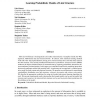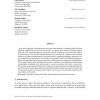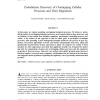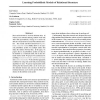JMLR
2002
14 years 6 months ago
2002
Most real-world data is heterogeneous and richly interconnected. Examples include the Web, hypertext, bibliometric data and social networks. In contrast, most statistical learning...
ML
2006
ACM
14 years 7 months ago
2006
ACM
In this paper, we describe the syntax and semantics for a probabilistic relational language (PRL). PRL is a recasting of recent work in Probabilistic Relational Models (PRMs) into ...
ILP
1999
Springer
14 years 11 months ago
1999
Springer
Most real-world data is heterogeneous and richly interconnected. Examples include the Web, hypertext, bibliometric data and social networks. In contrast, most statistical learning...
CONTEXT
2007
Springer
15 years 1 months ago
2007
Springer
The ability to model cognitive agents depends crucially on being able to encode and infer with contextual information at many levels (such as situational, psychological, social, or...
PKDD
2009
Springer
15 years 1 months ago
2009
Springer
Probabilistic relational models are an efficient way to learn and represent the dynamics in realistic environments consisting of many objects. Autonomous intelligent agents that gr...
RECOMB
2004
Springer
15 years 7 months ago
2004
Springer
In this paper, we explore modeling overlapping biological processes. We discuss a probabilistic model of overlapping biological processes, gene membership in those processes, and ...
KDD
2004
ACM
15 years 7 months ago
2004
ACM
Procedures for collective inference make simultaneous statistical judgments about the same variables for a set of related data instances. For example, collective inference could b...
ICML
2001
IEEE
15 years 8 months ago
2001
IEEE
Most real-world data is stored in relational form. In contrast, most statistical learning methods work with "flat" data representations, forcing us to convert our data i...




